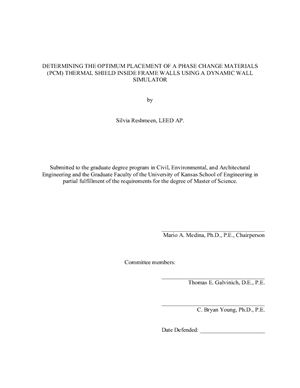На английском языке. Магистерская диссертация. Работа выполнена в
University of Kansas, 2009, 102 + XI pp.
Abstract
This thesis presents the results of an experimental study to determine the optimum placement and the thermal performance of a Phase Change Materials (PCMs) thermal shield incorporated into frame wall insulation systems for the purpose of reducing space cooling load energy use in residential and commercial buildings. The performance of the walls outfitted with the PCMs thermal shields was evaluated using a dynamic wall simulator. The interior of the dynamic simulator was designed to reproduce the conditions of the exterior of a conventional residential building wall and the exterior of the dynamic simulator represented the indoor conditions of a typical residential building since the dynamic simulator was located in an air conditioned research laboratory. Measurements of heat fluxes and calculation of percentages of peak heat transfer rate reductions were evaluated for 10% and 20% PCM concentration in the thermal shields along with two control walls. The main goals of using a PCM thermal shield were to reduce peak air conditioning demand, to shift the peak load, and to conserve energy. The results of this study show that the PCM thermal shields produce greater peak heat transfer rate reductions when they are placed further away from the heat source inside of the wall cavity and are less effective when temperatures are high. The 20% PCM thermal shield was more effective than 10% PCM thermal shields. For the optimal location of the thermal shield the reductions in peak heat transfer rates were in the range of 20-25% when compared with the control walls.
Abstract
This thesis presents the results of an experimental study to determine the optimum placement and the thermal performance of a Phase Change Materials (PCMs) thermal shield incorporated into frame wall insulation systems for the purpose of reducing space cooling load energy use in residential and commercial buildings. The performance of the walls outfitted with the PCMs thermal shields was evaluated using a dynamic wall simulator. The interior of the dynamic simulator was designed to reproduce the conditions of the exterior of a conventional residential building wall and the exterior of the dynamic simulator represented the indoor conditions of a typical residential building since the dynamic simulator was located in an air conditioned research laboratory. Measurements of heat fluxes and calculation of percentages of peak heat transfer rate reductions were evaluated for 10% and 20% PCM concentration in the thermal shields along with two control walls. The main goals of using a PCM thermal shield were to reduce peak air conditioning demand, to shift the peak load, and to conserve energy. The results of this study show that the PCM thermal shields produce greater peak heat transfer rate reductions when they are placed further away from the heat source inside of the wall cavity and are less effective when temperatures are high. The 20% PCM thermal shield was more effective than 10% PCM thermal shields. For the optimal location of the thermal shield the reductions in peak heat transfer rates were in the range of 20-25% when compared with the control walls.

